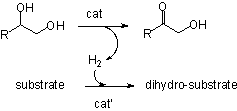

46828-AC3
Dehydrogenation Catalysis Relevant to Biomass Conversion to Chemicals and Fuels
This project is concerned with the development of new catalysts for the dehydrogenation of alcohols and with elucidating mechanistic principles defining such processes for polyfunctional alcohols that serve as biomass models. The longer-term goal is to utilize such catalytic systems for the degradation of biomass components to dihydrogen (or dihydrogen equivalents) plus carbon dioxide or for the disproportionation of such renewable feedstocks to higher value materials relevant to the petrochemical industry. Of particular interest is the development of new methodologies for the transfer of hydrogen equivalents from carbohydrates (including cellulose) to other substrates such as lignin (Scheme 1). With future supply challenges anticipated for fossil hydrocarbons, delineating catalytic strategies for the utilization of alternative feedstocks is clearly essential to sustained economic health. Furthermore, materials formed by photosynthesis are CO2 neutral and represent net solar energy storage, excluding the fossil fuels used in their production, harvesting and transportation. Thus, effective and efficient catalytic conversion of non-food biomass to transportation fuels or chemical precursors would be an important addition to the world's energy and supply portfolio.
Scheme 1:
The focus of
our ongoing studies proposed is the investigation of chemical transformations
that are models for key steps in the multiple catalytic cycles necessary for
the degradation of a polyfunctional substrate such as glucose or glycerol.
Having better mechanistic understanding of operating catalyst will provide
better insight into the design of more effective or selective homogeneous
heterogeneous catalysts. For example, vicinal diols are common motifs in
biomass-derived materials, but their catalytic dehydrogenations have only been
briefly studied.1 In this context, we have initiated an
investigation focused on the homogeneous dehydrogenation of the vicinal diols
1,2-propanediol (PDO) and 1-phenyl-1,2-ethanediol (PhEDO), as catalyzed by the
Shvo catalyst2 (Ru2{(3,4-Tol2-2,5-Ph2C5O)2H}(µ-H)(CO)4,
(1) and by Robinson's catalyst3
(Ru(CF3CO2)2(CO)(PPh3)2,
(2). These dehydrogenations were
operated in an open system in the acceptorless mode generating H2
quantitatively and in a closed system with the H2 acceptor diphenyl
acetylene.4 Although, we expected dehydrogenation of the primary
alcohol to aldehyde to be kinetically favored, the products appeared to be
exclusively the a-hydroxy
ketones as illustrated in Scheme 1. Since the latter is thermodynamically
favored, it may result from a subsequent isomerization the aldehyde to the
ketone. Ongoing studies are attempting to determine the possible intermediates
in the reaction. Parallel studies are evaluating the degradation of glycerol
and glucose to H2, CO and CO2 using more extreme
conditions and heterogenized ruthenium catalysts.
In a related study, we
are investigating the possible hydrogen transfer from alcohols to lignin models,
with the eventual goal of utilizing biomass derived H2 (or H2
equivalents) for the disassembly of lignin to more tractable monomeric or
oligomeric fragments. Lignin is a
heterogeneous biopolymer composed largely of 4-propylphenol derivatives coupled
primarily as ethers but
occasionally cross-linked with carbon-carbon bonds. We have found that porous
metal oxides (PMOs) obtained by calcination of transition metal substituted
Mg-Al hydrotalcite (HTC) precursors exhibit the properties of strong solid
bases. For example Fe-doped Mg-Al
PMOs are catalysts for transesterification reactions relevant to biodiesel
production.5 It was our premise that it would be possible to enhance
the effectiveness of base-catalyzed hydrolysis of the phenyl ethers in lignins
by introducing redox active transition metals into the formulation of the
hydrotalcite precursors. Somewhat serendipitously, we have found that new PMO
catalysts derived from 3:1 Mg:Al HTCs for which some of the Mg2+ was
replaced by Cu2+are effective for transfer of H2
equivalents from methanol to the lignin model compound dihydrobenzofuran under
supercritical conditions.6
The reaction appears to occur via sequential hydrogenolysis of the ether
linkage and hydrogenation of the aryl group with methanol as the hydrogen
source. Ongoing studies are directed toward evaluating such reactions using
other alcohols to provide the H2 equivalents and with lignin models
and for lignins themselves. References: (1) D.
Morton, D. J. Cole-Hamilton, Polyhedron 1987,
6, 2187-2189. (2) C. P.
Casey, S. W. Singer, D. R. Powell, R. K. Hayashi, M. Kavana. J. Am. Chem.
Soc. 2001, 123, 1090-1100. (3) A. Dobson, S. D. Robinson. Inorg.
Chem. 1977, 16, 137-142. (4) Catalytic
Dehydrogenation of Vicinal Diols, T. D. Matson, P. C. Ford, manuscript in
preparation (5) G. S.
Macala, A. W. Robertson, C. L. Johnson, Z. B. Day, R. S. Lewis, M. G. White, A.
V. Iretskii, P. C. Ford, Catal. Lets. 2008, 122,
205-209. (6) Hydrogen
Transfer from Methanol over a Solid Base Catalyst. A Model for Lignin Depolymerization, G. S. Macala, T. D.
Matson, C. L. Johnson, R. S. Lewis, A. V. Iretskii and P. C. Ford,
manuscript in preparation.
